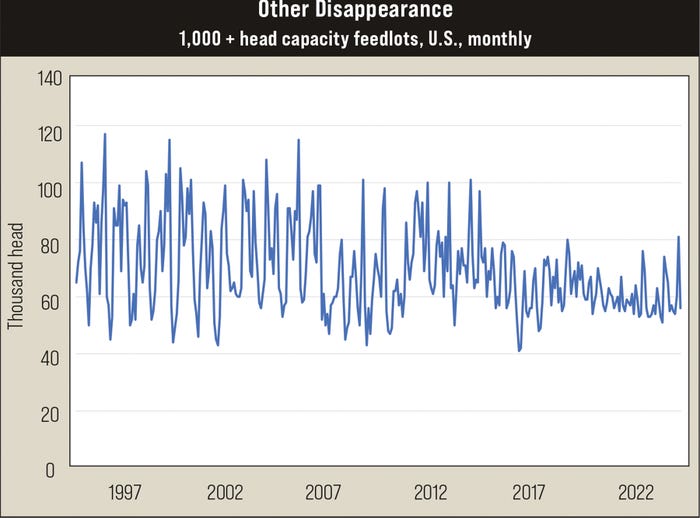April 8, 2024

Supply and demand drive cattle prices. To document this, USDA’s National Agricultural Statistics Service compiles a wealth of information on cattle supply from surveys of producers and publishes it in Cattle on Feed reports.
This “balance sheet” approach ensures estimates are as accurate as possible. Cattle on feed at the beginning of the month, plus placements, minus fed cattle marketings and other disappearance should equal cattle on feed at the beginning of the next month.
Other disappearance includes:
loss due to death
cattle movement from feedlots to pasture
shipments to other feedlots for further feeding
Cattle Price Reactions to Cattle on Feed Reports can be large. That makes accounting for even subtle inventory changes important.
Complicated head counts
During January, other disappearance from U.S. feedlots with a capacity of 1,000 head or more totaled 81,000 head. This was 18,000 head, or 29% above January 2023, and the highest since October 2014. February’s other disappearance totaled 56,000 head, 3% below February 2023.
USDA asks survey respondents to only include “steers and heifers being fed a ration of grain, silage, hay and/or protein supplement for the slaughter market that are expected to produce a carcass that will grade Select or better” in their on-feed inventories.
This, hopefully, keeps cattle intended to go to pasture from appearing on cattle-on-feed inventories. Those cattle will be included in placements when they go to a finishing feedlot and then on that feedlot’s inventory.
Similarly, feedlots backgrounding cattle for sale as feeders — or for further finishing in another feedlot — should not include these cattle in their on-feed inventory. USDA will include those cattle as placements when they go into a finishing feedlot.
Including them as on-feed inventory in the backgrounding lot would overstate market-ready and soon-to-be market-ready cattle supplies. If backgrounding cattle were incorrectly included in on-feed inventories, they would not appear as fed cattle marketings when they were sold as feeders or finished in another feedlot. They would end up in the selling or transferring a feedlot’s other disappearance. The larger the other disappearance, the more complicated the supply analysis becomes.
One exception to only including cattle intended for slaughter in the on-feed inventory exists. Producers sometimes pull heifers out of feedlots for breeding. Think of these as two-way heifers ― available for finishing or breeding. They should be included in on-feed inventories until they go to pasture, when they will appear as “other disappearance,” which usually peaks in May each year as grass becomes more available.

Source: USDA National Agricultural Statistics Service
Feedlots developing heifers and selling them as replacements is not new nor widespread, but it is a business opportunity. This is especially the case when values for replacement heifers are high.
Clue on cyclical expansion pace
Heifers moving out of feedlots for breeding will not hasten expansion significantly. At this point, the question should not be, “When will producers start rebuilding the herd?” Rather, it should be, “When will producers stop liquidating?”
Feedlots developing more heifers would help explain why both heifer retention for beef cow replacement and heifer slaughter are both low, but the number of heifers on feed is high. The next Cattle on Feed report will have the quarterly breakdown of steers and heifers on feed as of April 1. That will give clues on heifer disposition.
Conditions change plans
Feedlot closeouts were deep in the red in December and January. Marginal cost of gain changes rapidly. Feed, interest and out-of-pocket yardage costs are included in marginal cost.
Delays in marketing, at over 8% feeder cattle loan interest rates, are not insignificant. Marketing cattle sooner saves costs. Furthermore, opportunity cost of pen space was high as summer margins looked more profitable.
In the slaughter cattle section of the Iowa Weekly Cattle Auction Summary report, several lots have been denoted as “return to feed” so far this year. These cattle would be other disappearance from feedlots that marketed them and placements for feedlots that put them back on feed.
Other disappearance includes death loss. January’s wide temperature and precipitation gyrations stressed cattle and may have hiked feedlot death loss.
More meaning in residual
A “fudge factor” is an arbitrary mathematical term inserted into a calculation in order to arrive at an expected solution, or to compensate for errors, especially underestimation.
Cattle on Feed survey results are subject to mistakes in reporting. Cattle can be placed in and marketed out of feedlots every day. They can be hard to track.
Other disappearance is the residual that makes the cattle-on-feed number at the start of a month, plus placements, minus marketings during the month equal to the cattle-on-feed number at the start of the next month.
The more accurate the numbers are that producers provide to USDA for Cattle on Feed surveys, the smaller the fudge factor for other disappearance should be. This should make market implications from Cattle on Feed reports more reliable.
About the Author(s)
You May Also Like






